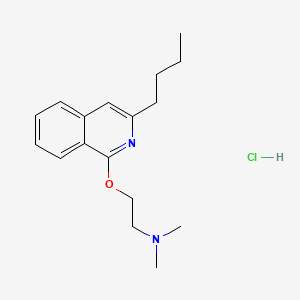



1. 3-butyl-1-(2-dimethylaminoethoxy)isoquinoline
2. Dimethisoquin
3. Dimethisoquin Monohydrochloride, Monohydrate
4. Isochinol
5. Quinisocaine
6. Quotane
1. 2773-92-4
2. Quinisocaine Hydrochloride
3. Dimethisoquin Hcl
4. Quinisocaine Hcl
5. Quotane
6. Dimethisoquin Hydrochloride (2 G)
7. Dimethisoquin Hydrochloride [usan]
8. Dsstox_cid_25373
9. Dsstox_rid_80835
10. Dsstox_gsid_45373
11. Dimethisoquin Hydrochloride (usan)
12. 2-(3-butylisoquinolin-1-yl)oxy-n,n-dimethylethanamine;hydrochloride
13. 3-butyl-1-(2-(dimethylamino)ethoxy)isoquinoline Monohydrochloride
14. Smp2689462
15. Ethanamine, 2-((3-butyl-1-isoquinolinyl)oxy)-n,n-dimethyl-, Monohydrochloride
16. Ncgc00016618-01
17. Cas-2773-92-4
18. N-{2-[(3-butyl-1-isoquinolinyl)oxy]ethyl}-n,n-dimethylamine
19. Mls002153920
20. Schembl467135
21. Chembl1533364
22. Dtxsid6045373
23. Hms1569n22
24. Tox21_110528
25. Dimethisoquinhydrochloride(2g)
26. Akos024326188
27. Tox21_110528_1
28. Ccg-220630
29. Dimethisoquin Hydrochloride [mi]
30. Ncgc00016618-04
31. Quinisocaine Hydrochloride [mart.]
32. Smr000769826
33. Quinisocaine Hydrochloride [who-dd]
34. D06661
35. Sr-01000854196
36. Sr-01000854196-2
37. Q27289288
38. 2-(3-butylisoquinolin-1-yl)oxy-n,n-dimethylethanamine,hydrochloride
39. 2-[(3-butyl-1-isoquinolinyl)oxy]-n,n-dimethylethanamine Hydrochloride
40. (2-(3-butyl-isoquinolin-1-yloxy)-ethyl)-dimethyl-amine, Hydrochloride
| Molecular Weight | 308.8 g/mol |
|---|---|
| Molecular Formula | C17H25ClN2O |
| Hydrogen Bond Donor Count | 1 |
| Hydrogen Bond Acceptor Count | 3 |
| Rotatable Bond Count | 7 |
| Exact Mass | 308.1655411 g/mol |
| Monoisotopic Mass | 308.1655411 g/mol |
| Topological Polar Surface Area | 25.4 Ų |
| Heavy Atom Count | 21 |
| Formal Charge | 0 |
| Complexity | 270 |
| Isotope Atom Count | 0 |
| Defined Atom Stereocenter Count | 0 |
| Undefined Atom Stereocenter Count | 0 |
| Defined Bond Stereocenter Count | 0 |
| Undefined Bond Stereocenter Count | 0 |
| Covalently Bonded Unit Count | 2 |
Anesthetics, Local
Drugs that block nerve conduction when applied locally to nerve tissue in appropriate concentrations. They act on any part of the nervous system and on every type of nerve fiber. In contact with a nerve trunk, these anesthetics can cause both sensory and motor paralysis in the innervated area. Their action is completely reversible. (From Gilman AG, et. al., Goodman and Gilman's The Pharmacological Basis of Therapeutics, 8th ed) Nearly all local anesthetics act by reducing the tendency of voltage-dependent sodium channels to activate. (See all compounds classified as Anesthetics, Local.)
